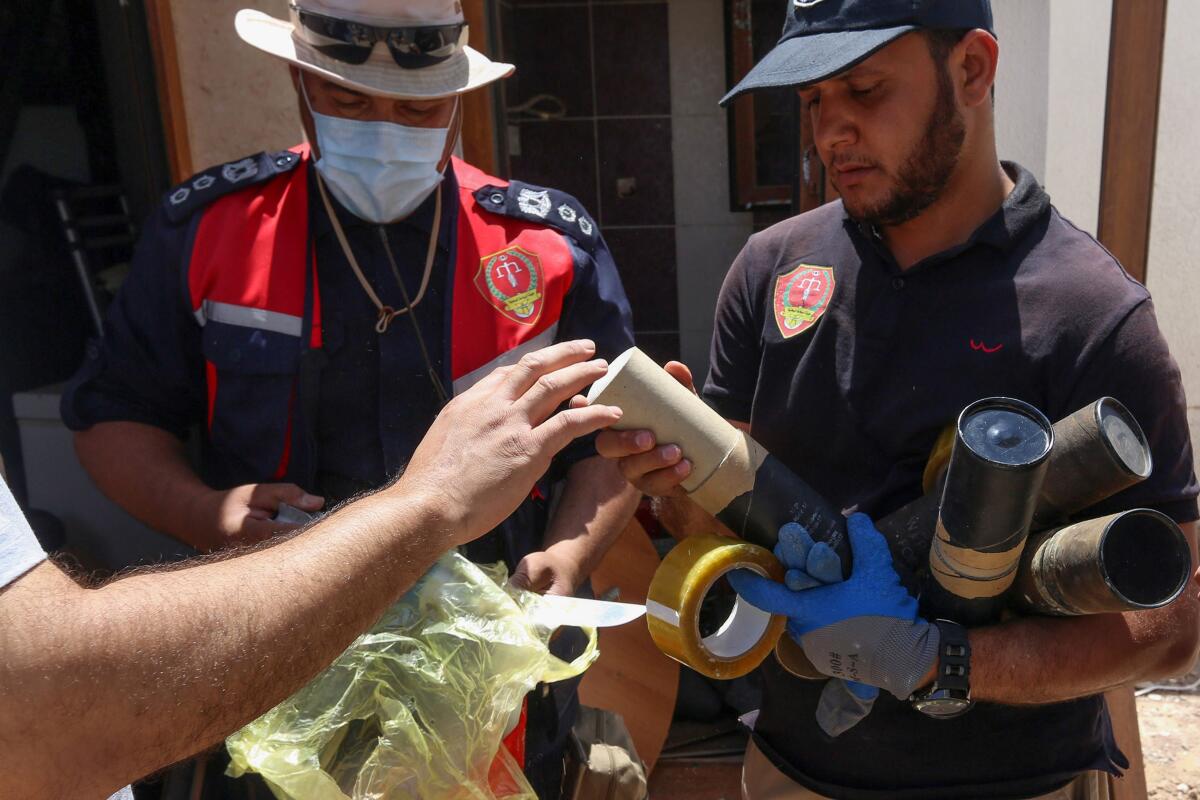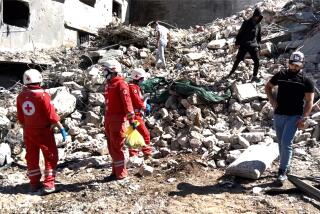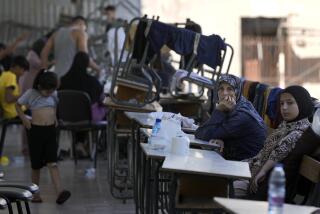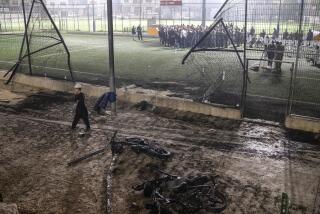For Tripoli residents, a grim homecoming to booby-trapped neighborhoods

BEIRUT — One mine was hidden behind a garage door. Another, buried under rubble, was rigged to blow near a gas tank. A particularly diabolical explosive, activists claimed, was taped to an abandoned teddy bear.
Fifteen months after rogue military leader Khalifa Haftar attacked the Libyan capital, Tripoli, his bid to capture the city and unseat the United Nations-recognized government there has ended in retreat. But in the two weeks since his forces pulled back from Tripoli’s southern suburbs, some 200,000 people displaced by the fighting face a new threat as they try to return home: hundreds of mines, improvised explosive devices, booby traps and unexploded ordnance left as a parting gift by Haftar’s fighters.
“There’s no military utility for this.… They’re just punishing the civilian population,” Mark Hiznay, associate director of the arms division at Human Rights Watch, said in a phone interview. “It’s the modern version of salting the earth.”
In the last 14 days, there have been more than 50 casualties among civilians — including an 8-year-old girl and a 14-year-old boy — and demining teams, said Abdel-Rahman Ghandour, Libya special representative for UNICEF, the U.N.’s children’s agency. Amin Hashemi, a media consultant for the Tripoli government’s health ministry, put the civilian death toll at 34, adding that every day there were fresh casualties among bomb-disposal personnel.
In the nine years since a North Atlantic Treaty Organization operation unseated longtime Libyan strongman Col. Moammar Kadafi, Libya has been a morass of militias and mercenaries, all fighting over the country’s gargantuan oil wealth with an eclectic mix of foreign-supplied weapons. Haftar, a 76-year-old aspiring strongman and onetime CIA asset backed by the United Arab Emirates, Russia and Egypt, began his assault on Tripoli in April 2019 as part of a campaign to secure the country under his rule.
Haftar’s forces, which U.N. investigators say included Kremlin-backed Russian mercenaries, pummeled their way to the southern edge of Tripoli. But the campaign foundered in recent weeks, as Turkey, an ally of the Tripoli government, dispatched arms and materiel to pro-government militias. They forced Haftar’s fighters into a chaotic retreat from their positions near the capital — but not before the fleeing forces seeded the area with ordnance.
“You’re talking about all of southern Tripoli, tens of kilometers, areas with clashes that had a huge population density,” Hashemi said in a phone interview.
The carnage has already brought condemnation from rights groups, U.S. officials and the U.N., which in a statement last month called the use of IEDs on civilians “grotesque.” This week, the Libyan Interior Ministry pleaded with civilians to wait until mine-riddled areas could be cleared.
Meanwhile, hundreds of videos illustrating the danger have cropped up on social media, many depicting people nervously tracing wires as they pick through trashed living rooms or uncovering mines camouflaged amid the bushes in their garden. Others show the bloodied bodies of homeowners and explosives experts or crates stuffed with spools of wire and factory-fresh mines.
“People are finding explosives in kitchens, under beds, in bathrooms. It’s barbaric. There’s no explanation why these areas were brutally mined,” Hashemi said.
“We even saw one in a children’s bedroom. Was the intention to hurt kids? These are things the mind can’t accept.”
The U.S. says Russian warplanes sent to back Moscow’s favored militia leader in Libya could open a new phase in the Middle East’s biggest proxy war.
The explosives have made returning home a fraught affair.
Jumaah Gheith rushed back with his son, Abdul Aziz, and nephew, Hassan, to inspect his farm in south Tripoli. Abdul Aziz opened the gate, and the car rolled in. That’s when a mine blew up directly under the car, instantly killing the father and the nephew. The blast threw Abdul Aziz aside, leaving his skin scored with cuts and burns.
“We buried the father and nephew the next day,” Adel Gheith, another nephew, told The Times. “The moment we finished the burial, I got news that Abdul Aziz had died.”
Abdul Baset Fhelboom was luckier. He survived the return to his home this week after fighting forced him to abandon it in December. But both he and his brother Reda as well as all their neighbors came back to homes that had been ransacked and looted. Many were ruined beyond repair.
“We couldn’t handle anything. We couldn’t touch anything. You’re afraid of wires,” Fhelboom said.
“There was methodical destruction. No house in the area is OK. And these are people who claimed they wanted to liberate Tripoli,” Reda said by telephone. He added that the living room in his house had been filled with stale bread and turned into a sty for pigeons and chickens.
It’s not the first time investigators have seen these tactics. Islamic State militants did the same in Iraq and Syria, bequeathing enemies an infestation of IEDs that, years later, authorities are still struggling to remove.
But there is a crucial difference, said Brian Castner, a former explosive ordnance disposal officer with the U.S. Army who now works with the watchdog group Amnesty International.
“ISIS’ bombs were self-manufactured. These are state-produced,” he said, referring to Islamic State by an acronym. “It’s a regression. It’s a step backwards from international norms to use banned state-manufactured landmines so extensively.”
Many of those mines, several weapons experts say, are of types not known to have been used in Libya and appear to have been recently supplied to Haftar by an outside actor.
“We’re used to seeing Belgian, Brazilian, North Korean, Italian and Chinese mines. And suddenly it’s all Russia or Soviet,” Hiznay said.
“By far, the mass of Russian antipersonnel mines is off the charts,” added Castner. “Some of it is brand spanking new, coming out of the box, clean as if it were in storage until the second they popped it open in Libya.”
It’s Ramadan in Tripoli, and come midnight the streets around the Kabir public garden are a melee of bumper-to-bumper traffic.
Other technical and circumstantial evidence — the placement of the mines, which include the MON-90, a Soviet-made mine similar to the Claymores used by the U.S. Army; the rigging of the wires; the warnings sprayed in Cyrillic lettering on walls to keep friendly troops away — point to Russian military expertise like that provided by Wagner Group mercenaries.
“We’ve seen this in Ukraine. The tactics line up, the timing lines up and you can make a pretty good case for the provenance” of the materiel, Castner said.
Another issue is the massive amount of ordnance left behind, or explosives that never blew up because of poor impact, including what one open-source researcher estimated to be “warehouses of ammunition” as well as artillery and mortar shells. Much of that came from Haftar’s backers, investigators say, despite Libya being under an international arms embargo.
Efforts to clear south Tripoli have been haphazard, with the perennially dysfunctional government scrambling to stop people from returning while crews finish their work. And the work is difficult, Hiznay said.
“Anything used with a trip wire, a metal filament that was extended, where you either increase or release pressure … and it becomes devilish to find them,” Hiznay said. “You have to do it the hard way. There’s no technological silver bullet. It’s trained eyes.”
Scenes from southern Tripoli
Aid groups including UNICEF have offered assistance, training forensic police to trace explosives, as well as providing awareness education to about 18,500 children and caregivers, Ghandour said.
But the scale of the problem is large, he added, and people are desperate.
“These people have been away from their homes for a year and three months, but it’s still a very, very contaminated area,” he said.
“It will take many more days, if not weeks, for the demining and the experts to make sure the area is safe.”
More to Read
Sign up for Essential California
The most important California stories and recommendations in your inbox every morning.
You may occasionally receive promotional content from the Los Angeles Times.











